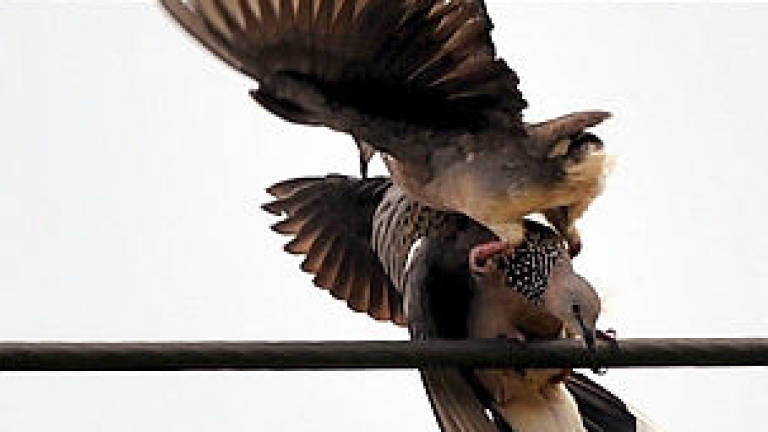Catching wild doves in the heart of KL

KUALA LUMPUR: Ensnaring wild tekukur (spotted dove) is a pastime that typically takes place in the jungle.
However, Syed Umno Syed Yahya found that it could also be carried out within the concrete jungle of Kuala Lumpur.
Today, the 62-year-old would go to the Kampung Boyan Flood Retention Pond to catch the doves armed with his "tools".
This comprises a jebak (trapper), denak (another dove used as a decoy/call-bird) and racik (small lasso used to hook a bird's legs).
Along with his friend who wants to be known and only Pak Din, they will set up three jebak on a tree branch and a tekukur to call for the wild bird.
The trees planted around the pond have become home to several species of birds including egrets, swallows and zebra doves.
If they are lucky, a wild tekukur will become attracted by the cooing of its tame counterpart and approach it and this is how it gets ensnared.
An ancient art
Attracting the wild tekukur using jebak and denak is an art perfected by the older generation and taught to the next.
It is a pastime that is not only appealing to the old but youths as well. Captured doves that produce good 'melody' can fetch a lucrative price in the market.
Pak Din, 68, who is from Kuala Kangsar, Perak said he learned to attract birds since he was eight years old and continued with the hobby when he moved to Kuala Lumpur in 1973.
Syed Umno, a retired government servant, also fell for the same hobby when both met in KL in 1986.
"Now that I have retired, we get together more often to do this, especially during the weekends," said Syed Umno, who is a former Kuala Lumpur City Hall employee.
"It is a fun way to spend our free time," said Pak Din, who lives in Keramat.
Recreational parks around KL, particularly the Sungai Bunus Park in Setapak are often packed with people during the weekends. Wild tekukur can easily found in the area as well as in flower gardens and bushes.
Pak Din and Syed Umno would ride their motorcycles to their area of choice at around 8am to set up their trap at suitable locations, such as the low branches of trees or on stakes that would be attached to higher spots.
"Sometimes we would be waiting from morning to evening but go home empty handed.
"It is a hobby that requires a lot of patience but we can become quite engrossed in it," said Pak Din.
Melody
The voice of the tekukur that acts as a decoy is the most important aspect when choosing a dove to use as a call-bird.
"Doves with strong and melodious cooing have better potential as a call-bird," said Pak Din.
A call-bird's aggressiveness also increases the chances of wild doves flying into the trap to confront it. Other aspects that are looked into when determining the quality of a call-bird are the ease of taming and training it.
"If the bird caught is of poor "quality", I would release it or give it to friends. I only keep those that can be used as call-birds.
"Some are also sold at prices depending on their quality. I've sold for between RM200 and RM1,500 a bird," he said.
Pak Din preferred to place the call-bird in a jebak during the process as it ensures its safety.
When the wild dove steps onto the stick placed at the jebak, it would be caught in a net.
Syed Umno, meanwhile, preferred to use a racik placed near a call-bird.
"When the wild dove comes to challenge the call-bird, its feet would get caught in the loop of the racik," he explained.
Handmade
Making a jebak requires a high level of craftsmanship. Not many have the skill to make one as the process could be quite complicated, said Pak Din.
However, Pak Din himself was fortunate enough to be able to make one without formally learning from its craftsmen.
He was able to construct one himself based only on finished models.
"It is one of the ways I can save. I have never learned under any jebak craftsman. This talent is a gift from God," said Pak Din who has made over 20 jebak including the ones used to trap quails, which require a high level of detail.
It takes about a month and a half to complete a jebak, which is crafted from recycled teak and mahogany.
According to Pak Din, a jebak could last very long if it is not constantly exposed to rain and heat.
Although their family members do not share the same passion, both men hoped that the pastime would be picked up by the younger generation so that it could continue for generations to come. — Bernama